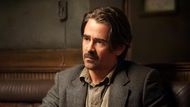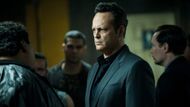True Detective came out on HBO in January of 2014 and was a hit right away. Created by Nic Pizzolatto, the show stood out with its cinematic look, philosophy-infused themes, and structure that made each season its own standalone story. The first season, starring Matthew McConaughey and Woody Harrelson as two troubled detectives in Louisiana, was praised for its dark tone, complex plot, and richly detailed characters. It was a deconstruction of evil, time, and humanity in general, brought to the screen with a seriousness and sophistication more typical in films than on television.
True Detective Season One’s popularity was unprecedented for the majority of cable dramas. It had good ratings, universally positive reviews, and won several major awards. It also left a mark on the industry, causing other shows to test anthology formats, cast big-time stars, and try a more cinematic approach. The show’s influence even reached beyond television—McConaughey’s career got a boost, and expectations for what television could accomplish were heightened.
All of that created huge expectations for True Detective Season Two. As it rolled into 2015, it came with a new cast, a new setting, and a new case—along with a wave of controversy, ambivalence, and disappointment still being debated today.
Now it's time to take a closer look at True Detective Season Two—its story, its themes, its reception, and the always-haunting question: worth watching, or left to gather dust? Here’s setting it all out.
The True Detective anthology: Structure and legacy

Before leaping into Season 2, let's see how True Detective is structured. Every season stands alone—with new characters, worlds, and narratives. The anthology format was not new (American Horror Story and Black Mirror preceded it), but True Detective pushed the bar higher. It added serious storytelling, brief seasons, and high-profile talent to the mix.
Season One, set in rural Louisiana, tracked detectives Marty Hart and Rust Cohle as they unraveled a dark, decades-spanning conspiracy. It was successful due to the moody directing of Cary Fukunaga, the philosophical edge, and two dominating lead performances. The series broke boundaries. It brought anthology series into prominence, got movie stars on TV, and established that television could be every bit as ambitious as film.
True Detective season two: Setting, story, and cast

True Detective Season two dropped in June 2015 and took a drastically different direction from what Season one had taken. The setting changed to Vinci, a gritty industrial city in LA County. Bayous were a thing of the past—now there were freeways, smog, and corruption. Four main characters spearheaded the story this time:
Ray Velcoro (Colin Farrell): A cop caught in a mire of addiction, police corruption, and a bitter custody battle.
Ani Bezzerides (Rachel McAdams): A Ventura County cop with a tough exterior and troubled past.
Paul Woodrugh (Taylor Kitsch): A war veteran and patrol officer trying to outrun his tragedy and identity crisis.
Frank Semyon (Vince Vaughn): An ex criminal turned legit businessman who tries to reform himself, only for his life to turn upside down after the murder of a city government official.
That murder—of city manager Ben Caspere—is what puts it all in motion. Woodrugh stumbles upon the body, and the case rapidly spirals into something more. As the detectives dig in, they uncover land scams, sex trade, and dirty politics. Each of them is bringing personal baggage to work, and the line between who they are and what they’re investigating starts to blur.
True Detective Season two isn’t built around one tight duo. It juggles four leads, each filled with their own history and damage. The narrative is dense, replete with real estate fraud, political intrigue, and plenty of extras. The mood is somberish—there’s not much light or happiness.
Critical and audience reception: The great divide

When Season 2 of True Detective arrived, fever pitch was reached—and the reaction was instant and merciless. People and critics wrestled with the plot, the relentlessly dark atmosphere, and the characters, which were less engaging than Season One’s. Performances—specifically those of Farrell and McAdams—were praised. As were the visuals. But the writing and pacing did not stand a chance.
Rotten Tomatoes summarized its essence this way:
"Despite some memorably grizzled performances, True Detective’s second season is florid to a fault and so unrelentingly grim that it becomes about as much fun as being stuck in L.A. traffic."
Critics mentioned “slick overproduction” and “fundamental incompetence” as the principal issues. The majority of them stated it could not stand on its own and was overshadowed by what had come before.
Most of the criticism amounted to comparisons. True Detective Season one had it exactly right—a tightly scripted season, strong directing, an atmospheric tone, and two unforgettable actors. Season two was missing its Cary Fukunaga, had a more fragmented structure, and a tone some saw as overcorrecting. The standard had been set almost impossibly high. Anything less than another home run felt like a letdown.
A few critics and fans, though, came to rethink later on. Season two is still imperfect, but there’s more respect for its ambition and for not following Season One’s template. It’s now seen by some as an ambitious, flawed noir that tried something different—and maybe deserves more respect than it got.
Why did True Detective season two "fail"?

True Detective Season two is densely packed. It has involved investigations, backroom politics, and a big ensemble cast. It’s dense—too dense, maybe. Lacking a visible bad guy or the all-encompassing mystery of Season One, the story can go anywhere. For some, it was untrackable and even harder to care about.
The acting was sound, but the characters never came together. They’re bruised and dark, but not necessarily engaging. They don’t have a spark—a bond like Hart and Cohle. The show pushes very hard into trauma, but what’s offered often feels heavy-handed or overdone.
Season one had a tight, cohesive look and feel—courtesy of Cary Fukunaga directing every episode. Season two did not. With multiple directors, the tone shifts, and the magic is lost. What was haunting and mythic before now starts to resemble generic noir, even if it does look pretty.
Season two did not wish to be a retread. New city, new feel, new story. That’s exciting—but dangerous. True Detective takes on big concepts such as city decay, corruption, and power, but there’s just too much to cram into eight episodes.
Why some fans still defend season two?

Season two took no prisoners. Instead of remaking Season One, Nic Pizzolatto scaled it up. He scripted a dirtier, more politicized story. It digs into California’s darker corners—public corruption, backroom politics, and the human cost of dirty power. It’s richly thematic, even if it doesn’t all land neatly.
Even the detractors acknowledge the cast did improve. Colin Farrell, Rachel McAdams, and Vince Vaughn all brought serious heft. Their characters are broken but genuine. The show still looks good, too—maybe not as distinct as Season One, but still sleek, uncovering the sheen and decay of Southern California.
With time, Season two has found a second lease on life. Apart from the hype, a few fans look at it differently now. Its experimentation, dark tone, and layered construction now look like strengths rather than weaknesses. It’s not concerned with pleasing—it’s concerned with presenting. And to some, that’s exactly the idea.
Why others say "skip it"?
The tale is thick—and not in a fun way. Too many characters, too much action, and not enough lucidity. The mystery never takes hold, and the payoff isn’t satisfying. It’s easy to get lost, and hard to care.
Season two is bleak from start to finish. There’s very little respite or even comedy. That noir atmosphere can work—but here, it simply wears thin. The trauma that the characters are going through piles up without providing much payback. It feels more exhausting than it is fascinating.
Season one set the bar so high. Season two couldn’t live it down. No mythic duo, no common vision, and a vastly altered atmosphere. That shift may have worked in isolation—but as a companion to what came first, it was disappointing to most.
Should you watch or skip True Detective season 2?

Watch it if...
You’re into dense, moody stories where nobody’s clean and nothing’s simple. Season two leans hard into classic noir—corrupt systems, broken people, and a whole lot of moral gray.
You respect a show that takes big risks, even if not all of them pay off. This season aims high. The ambition, acting, and atmosphere make it worth a look, flaws and all.
You’re a fan of the True Detective format or anthology shows in general. Like it or not, this season is part of the bigger story.
Skip it if...
You’re expecting another Rust and Marty. This is a different ride—less focused, less philosophical, and way less cohesive.
You’re not up for a heavy watch. The season is dark—emotionally, visually, thematically. There’s no let-up.
You like your stories tight and lean. Season two opens up broad, with complicated plots and minimal payoffs. It is an infuriating show if you are not committed to the sprawl.
